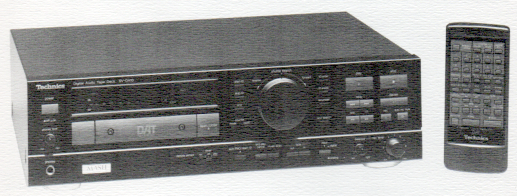by Jerry Vigil

Look out! It's the invasion of the consumer DAT machines! Remember when you perused the catalogue of your favorite equipment distributor and drooled over the many DAT machines to choose from but cringed at the price tag you knew your boss would never approve? -- two thousand dollars, three thousand dollars, four thousand dollars. Finally, after over three years of political ping-pong and too much hoopla about all the "pirating" that would occur if consumers got their hands on these babies, DAT machines are appearing in your favorite home stereo store. Sony has a couple. JVC has a pair. Technics has the lowest priced model, and that's the one we decided to pick on.
The Technics SV-DA10 DAT deck is priced in the current Allied catalogue for $695! We saw the Sony DTC-700 at Highland Appliance for $799. Sony's healthier DTC-75ES runs $950. We haven't located the JVC models yet but JVC says they're out there. The XDZ-505 from JVC is available for around $1,000. Their other model, the XDZ-1010, lists for around $1,700.
The prices are right, at least in comparison to the tags on "pro" decks, but what is the difference between a "pro" deck and a "consumer" DAT machine, and do these differences really matter to those of us in the production room? To begin with, the consumer decks have the famous SCMS copy-protect circuitry. Other than that, it's a matter of features that will appeal to the studio engineer versus features that the consumer will appreciate. (In plain layman's terms, the difference is that a "pro" deck has more buttons and takes more paychecks to buy than a "consumer" deck!) Pro decks will have features on them like time code capabilities, multiple sampling frequencies, balanced ins and outs, pitch shifting, multiple digital format interfaces, big "broadcast" buttons, and ads in MIX instead of Audio magazine; but many of these features are unnecessary for the functions of radio production. For radio production, a consumer DAT may well serve its purpose and leave dollars to spend on other goodies.
The SV-DA10 is a "no frills" deck in comparison to more expensive models. There are a few nice features not found on other decks, but most features are nothing less than you'd expect as "standard" on a DAT deck. Along with the SV-DA10 comes a remote control which is necessary for some of the functions. More on that later. Starting with the front panel controls on the deck, here's what you get:
To the left of the display and cassette tray are the power switch, headphone jack, and headphone volume control. The cassette tray itself assumes you know how to insert a DAT cassette. Some units will reject the cassette if inserted backwards or upside down, and the tray will open back up letting you know you goofed. If a cassette is placed in the SV-DA10's tray the wrong way, the tray will close and the machine simply won't function, though it will try.
To the right of the display and cassette tray is the "start ID" button which is used with the "ID write" button to manually or automatically record start ID's during playback. (As with any DAT machine, start ID's are recorded automatically on the SV-DA10 during the recording process unless the "auto PNO/start ID" button is pressed to disable automatic function.) The "skip ID" button is also used with the "ID write" button to record "skip ID's" during playback. Upon subsequent playback, when a skip ID is encountered, the unit fast forwards to the next program thus skipping unwanted material. (This standard function of DAT machines is aimed at the consumer market and is used primarily to skip over such "unwanted" stuff as commercials and Barry Manilow songs when taping your favorite radio station.)
An "end" button records an "end ID" on the tape, and is used with the "end search" button. This nice feature comes in handy when recording over pre-recorded tapes. Most decks have an "end search" function which locates the beginning of unrecorded tape. This is fine if you're working with fresh tape; but if you've recorded thirty minutes into an old tape and want to start recording from that point, hitting "end search" won't get you there. With the "end" button on the SV-DA10, an "end ID" can be placed anywhere on the tape. Thereafter, when the "end search" function is used and the unit sees the "end ID," it thinks it has found "unrecorded" tape. (This is another "consumer" feature since they are most likely to record over old tapes regularly.)
The "renumber" button is another common DAT function. This function automatically renumbers all start ID's sequentially starting with the number one. It comes in handy if programs have been recorded without ID numbers or, if for some reason, you've erased start ID's here and there. The counter's "mode" and "reset" buttons affect the display, which we'll get into in a moment.
The right side of the front panel has your standard "play," "stop," "skip," "pause," "record," "rewind," and "fast forward" buttons along with an "auto/record mute" button. The "auto/record mute" function, when pressed during recording, mutes the input for four seconds then places the unit in the record/pause mode. This is another handy "consumer" function used when recording a radio station. When the newscast starts, you can press this button to pause the recording. If you later use the renumber function, the four seconds will be enough to tell the unit that a new program is next. The four second gap can be shortened by pressing "pause" before the four seconds have elapsed, and you can extend the muted portion of the recording indefinitely by simply holding the button down.

